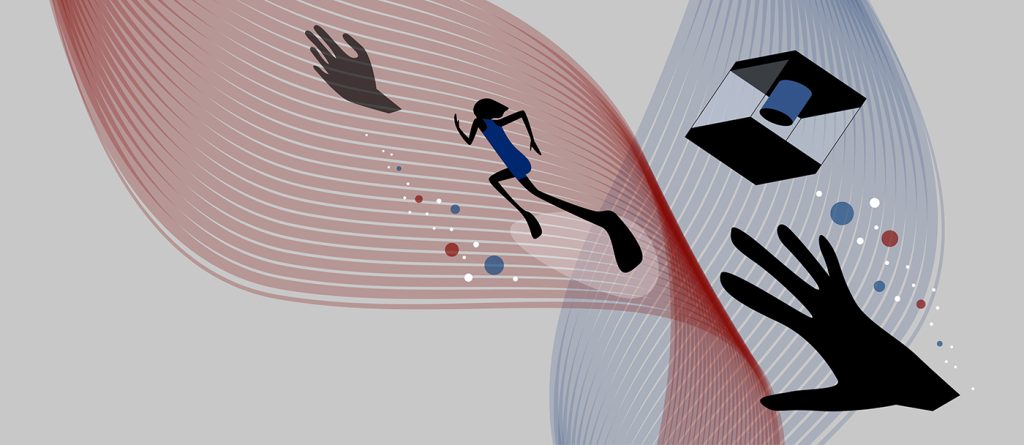Submitted by Sabrina Patsch
on December 16, 2021

** QUANTUM SHORTS 2021/2022: RUNNER UP
>> Read an interview with the author
As her body lapsed into stupor, the audience burst into raucous cheers. The faint euphoria of having reached the stabilizer point in one piece was overshadowed by the oppressive feeling of being trapped. The sensation frightened her every time anew, but she had to stabilize every few steps if she didn’t want to decohere. If she waited for too long, her body would drift apart like smoke in the wind. She wondered what that would feel like. Would she feel like being everywhere at the same time? Or would she not feel anything at all anymore, with her body and brain being smudged over the whole arena?
It’s a lot to think about. But now was not the time for these kinds of questions. If she wanted to get out of this arena alive, she had to focus on the game.
The rules were as simple as can be: be the first to reach the other side of the arena. The distance wasn’t even particularly long. In a classical world, she could have reached the exit in about a minute. But this race was not about speed. It was about strategy, courage, and a lot of luck.
She heard a whirring sound as a fist-sized drone buzzed into her field of vision. A close-up of her face would now be seen on the stadium screens and on thousands of televisions. She heard a low murmur from the audience and for a moment she wondered what her face looked like. Was she frozen in a grimace? But since she couldn’t change it anyways, she pushed the thought away and studied the ground in front of her instead.
The floor was covered irregularly with circular, milky-white platforms about a meter in size. It reminded her of a confetti-strewn floor the day after a giant’s party. Only that each platform was a life-saving stabilizer point which made her wave function collapse into a human body. In the rest of the domed arena, the gamemasters had increased the degree of quantum coherence massively. So massively, that even objects as huge as – let’s say – human beings behave like quantum objects. What began as science had now turned into a crude game show.
In order to make it to the other side, she had to choose just the right distance between the stabilizer points. If she stabilized too early, chances were that she collapsed into the exact same spot she had tried to leave. If she tried to stabilize too late… In the best case, she would just collapse to an entirely different point, possibly even further away from the exit. That had happened to her already several times. In the worst case, she would collapse to several points at the same time. She had seen that happening to one contestant; it was not pleasant. Other contestants never collapse again. They dephased too much to trigger the stabilizer points. On second thoughts, she couldn’t tell if that was better than being torn apart – or much worse.
At the moment, she could only see one other contestant from the corner of her eye. He stood several meters behind her, facing the opposite direction. Then, suddenly, he started running. No sooner had he left the platform than his features blurred. First only mildly, as if she had forgotten to put her contact lenses. But with every step, the streaks he drew not only behind him but, strangely, also in front of him grew longer. The audience gasped and shouted, whether to motivate or distract the contestant was not clear to her.
She knew she had to move herself, but she couldn’t bring herself to look away. Parts of him bunched together on two different tracks. He lurched around one more corner and then jerked onto a stabilizer point – and he collapsed properly into one person. The audience broke out in a frenzy. They cheered and howled as if he had made it to the exit already. Yet, he was still a good ten steps away. To her dismay, for it was much closer than she was.
This new situation left her with no choice. If she wanted to reach the exit before him, she had to run now while he was still stabilizing. Before she could change her mind and let the fear creep in, she focused on one thought, virtually shouted it in her mind: run!
Every platform was equipped with a sensor that measures the participant’s brain activity. When they tried to start running, the stabilizer shuts down and releases the participants from their confinement. Overcome by the sudden freedom, she stumbled forward and almost fell, before catching herself and bolting into a sprint. The audience resumed roaring and clapping, and the drone approached her with an excited hum. At this moment, however, she couldn’t care less. All she cared for was the big, shimmering gate that marked the exit of the arena. She danced around the platforms; she could not afford another stabilization. If she did not reach the exit now, she had no chance of beating her opponent.
After another step to the left right, she started to feel dizzy. The gate was drifting out of focus, and she was tempted to rescue herself into the protective captivity of a stabilizer point. Instead, she jumped dodged another platform and shook her head slightly fanatically, trying to clear her mind. Worry panic seized her, but she forced herself to keep running while feeling increasingly uneasy dead sick. Only one last still fifty steps when she broke into happy tears of pure desperation. She could never make it to the gate was within reach and she didn’t know where she was certain she was winning as sheer terror wept over her when she realized she would win die and never ever enter never leave this arena again.
About the Author:
Sabrina Patsch is a German quantum physicist and freelance science journalist. In her free time, she enjoys reading, making music, and writing stories in which she weaves parts of her research. Her first story was published in an anthology in autumn 2021. Read more about Sabrina on her blog: physicus-minimus.com



